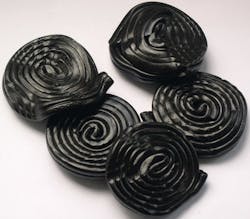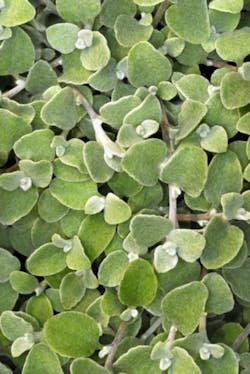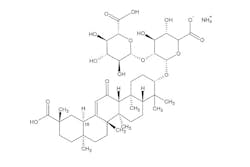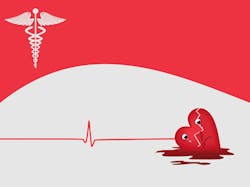Toxic candy?
Licorice is a plant, and is used as a sweetener, a thirst quencher, in various candies and drinks, and its root has some medicinal applications. Licorice is used for various digestive system issues, such as stomach ulcers, heartburn, colic, and chronic gastritis. Some individuals use it for a sore throat, bronchitis, cough, and infections caused by bacteria or viruses. Licorice is also used for osteoarthritis, systemic lupus erythematosus (SLE), liver disorders, malaria, tuberculosis, food poisoning, and chronic fatigue syndrome (CFS). But how safe is it, and what are some of the complications of eating licorice?
Liquorice root has been used in Europe since prehistoric times, and is well documented beginning with the ancient Greeks.(1) It is an extract of the plant Glycyrrhiza, whose name is derived from the Greek word "glykos," meaning sweet, and "rhiza," meaning root.(2) Licorice extracts and its principle component, glycyrrhizin, have extensive use in foods, tobacco and in both traditional and herbal medicine.(3) In the USA, it is recognized as a safe flavoring agent and is accepted in many countries as a healthy natural substance. As a result, there is a high level of use of licorice and glycyrrhizin in the US. Biochemical studies indicate that glycyrrhizinates inhibit 11beta-hydroxysteroid dehydrogenase, the enzyme responsible for inactivating cortisol.(3) As a result, the continuous, high-level exposure to glycyrrhizin compounds can produce hypermineralocorticoid-like effects in both animals and humans. These effects are reversible upon withdrawal of licorice or glycyrrhizin. Some in vivo and clinical studies have reported beneficial effects of both licorice and glycyrrhizin consumption, including anti-ulcer, anti-viral, and hepatoprotective responses.(4)
However, according to some researchers, the health benefits of licorice are minor compared to the potential adverse outcomes of chronic use.(4) There are many complications associated with excess licorice intake, but effects on the cardiovascular system are the most serious.(2) The tolerable upper limit of licorice ingestion has been provided by several societies. The European Union (EU) suggested that regular ingestion of glycyrrhizin should not exceed 100 mg/day (found in 60–70 g of licorice).(5) At that time in 1991, the Committee of the EU considered it wise that regular ingestion of licorice should not exceed 100 mg/day, though it was unequivocally mentioned that this was a conditional figure. Since then, new toxicological information, including data from human volunteer studies, has become available. Although these data provide a stronger basis for the upper limit for regular ingestion of glycyrrhizinic acid of 100 mg/day, the Committee still believes that an tolerable daily intake (ADI) for glycyrrhizinic acid and ammonium glycyrrhizinate cannot be derived because the new human toxicity studies are too limited (small experimental groups, short duration). The EU Committee believes that this upper limit for regular ingestion of 100 mg/day provides an appropriate level of protection for the bulk of the population. It is noted that this upper limit includes the intake of glycyrrhizinic acid via all products, liquorice confectionery as well as glycyrrhizinic acid- or ammonium glycyrrhizinate-flavoured products.
(5)glycyrrhizinic acid The most common examples of licorice toxicity are severe hypertension, hypokalemia, and myopathy, and the most severe is its cardiovascular complications.(2) Because of depletion of potassium due to excessive licorice intake, cardic arrhythmias can occur. When there is too little potassium in the blood, it is called hypokalemia. Cardiac arrest can also occur.
The bottom line is that people with history of cardiac disease should be strongly warned about excess licorice intake. Those who are more susceptible to arrhythmias should minimize their licorice intake especially if they are concurrently on medicines that lower potassium level, such as thiazide or loop diuretics. Those with congestive heart failure or resistant hypertension should avoid licorice-containing products because of its salt-retaining effect. As well, if one is taking digoxin or warfarin, they should be advised of potential toxicity. These recommendations should be more emphasized in countries that are known to be higher consumers of licorice.
References 1. Fiore C, Eisenhut M, Ragazzi E, Zanchin G, Armanini D. J Ethnopharmacol. A history of the therapeutic use of liquorice in Europe. 2005 Jul 14;99(3):317-24. 2. Omar HR. The cardiovascular complications of licorice. Cardiovascular Endocrinology 2013, 2:46–49. 3. Isbrucker RA, Burdock GA. Risk and safety assessment on the consumption of Licorice root (Glycyrrhiza sp.), its extract and powder as a food ingredient, with emphasis on the pharmacology and toxicology of glycyrrhizin. Regul Toxicol Pharmacol. 2006 Dec;46(3):167-92. Epub 2006 Aug 1. 4. Asl MN, Hosseinzadeh H. Review of pharmacological effects of Glycyrrhiza sp. and its bioactive compounds. Phytother Res. 2008 Jun;22(6):709-24. doi: 10.1002/ptr.2362. 5. Scientific Committee on Food. Opinion of the Scientific Committee on Food on glycyrrhizinic acid and its ammonium salt. Brussels: European Commission Heath and Consumer Protection Directorate General 2003; Available at: http://ec.europa.eu/food/fs/sc/scf/out186_en.pdf. Accessed December 16, 2013.




